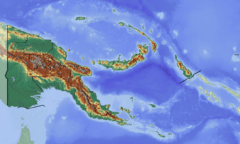Choerophryne sanguinopicta facts for kids
Quick facts for kids Choerophryne sanguinopicta |
|
|---|---|
| Conservation status | |
| Scientific classification | |
| Synonyms | |
|
Albericus sanguinopictus Kraus and Allison, 2005 |
The blood-painted frog (Choerophryne sanguinopicta) is a tiny frog that belongs to the Microhylidae family. This family includes many small, often round-bodied frogs. This special frog lives only in southeastern Papua New Guinea. It has only been found near Mt. Simpson, in the Owen Stanley Range. Scientists think it might live in other nearby areas too. Its scientific name, sanguinopicta, comes from Latin words meaning "blood" and "painted." This is because the frog has cool red spots and marks on its skin.
What Does It Look Like?
These frogs are quite small. Male frogs are about 23 to 27 millimeters long. Female frogs are a bit bigger, measuring 28 to 33 millimeters. Their snouts are rounded, and they have medium-sized eyes.
The skin on their back is usually pale blue or green. It is covered with dark brown spots and tiny brick-red dots. Their belly is a lighter bluish-green. It has bright brick-red or orange-red blotches. Some frogs might even have a yellowish-orange color mixed in.
Where Does It Live?
The blood-painted frog lives in forests on mountains. It prefers areas where the forest is a bit open. You can also find it near the edges of forests and rivers. These frogs live at high altitudes, from about 1,400 to 1,540 meters above sea level.
Male frogs call out at night. They sit on leaves and stems, usually about 1 to 3 meters off the ground.
Why Is It Important to Protect Them?
This frog is facing a big problem: frequent fires. These fires are often started by people to help with hunting. Even though there were many of these frogs where they were first found, they seem to be spread out in small groups. Protecting their forest home from fires is very important for their survival.



